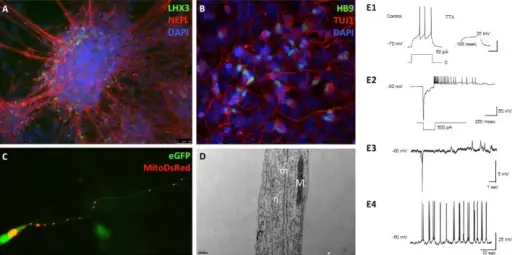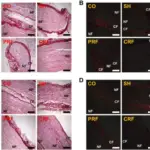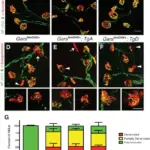
Inherited Peripheral Neuropathies. Induced pluripotent stem cells (iPSC)-derived motor neurons exhibited protein expression, ultrastructural and electrophysiological features of mature motor neurons. After long-term culture (over 45 days), expression of the medial motor column marker LHX3 (A) and the somatic motor neuron transcription factor HB9 (B), as well as neuronal cytoskeletal proteins (NEFL and TUJ1), could be observed in most of the neurons. Note that, at this time point, spinal cord motor neurons tend to cluster (scale bar for A = 50 μm). (C) Motor neuron cultures can be transfected with an enhanced green fluorescent protein (eGFP) and mitoDsRed plasmids to study axonal mitochondrial trafficking in axonal (type 2) inherited neuropathies. (D) Ultrastructural imaging of an axon revealed typical features including the presence of cytoskeletal proteins (n = neurofilament and m = microtubules) and mitochondria (M) (scale bar = 0.5 μm). Current clamp recordings of iPSC-derived motor neurons demonstrate tetrodotoxin (TTX) sensitive action potentials elicited by depolarizing current step (E1) and Ih current elicited by hyperpolarizing current step (E2). Spontaneous IPSPs and excitatory post-synaptic potentials (E3) and spontaneous bursts of action potentials (E4) could also be identified in these cultures. From Saporta et al. (2015). Cellular reprogramming and inherited peripheral neuropathies: perspectives and challenges: Saporta MA - Neural regeneration research (2015). Not altered. CC.
Inherited peripheral neuropathies are diseases of the nerves that one inherits from the parents.
Examples of Inherited peripheral neuropathies include:
- Charcot-Marie-tooth disease
- Neuropathy due to familial amyloidosis
- Hereditary motor neuropathies
- Hereditary sensory neuropathies
- Neuropathy due to Inherited metabolic diseases



